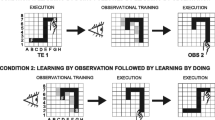Abstract
The present investigation studied observational learning in autistic children. Fifteen autistic and 15 normal children watched an adult model engage in a set of behaviors under specific verbal instructions. After observing this situation, the children were tested to determine what they had acquired through observation. The results showed that (1) the majority of the autistic and the youngest normal children acquired only some limited features of the observational situation and (2) chronological age was related to the amount of learning through observation in the normal children but not in the autistics. The deficit that the autistic children showed in observational learning may be related to a failure to discriminate or attend to the total stimulus input presented. Their failure in observational learning can be seen to contribute in a major way to the severely impoverished behavioral repertoires of these children.
Similar content being viewed by others
References
Baer, D. M., Peterson, R. F., & Sherman, J. A. The development of generalized imitation by reinforcing behavioral similarity to a model.Journal of the Experimental Analysis of Behavior, 1967,10, 405–416.
Bandura, A.Principles of behavior modification. New York: Holt, Rinehart & Winston, 1969.
Bandura, A. Psychotherapy based upon modeling principles. In A. E. Bergin & S. L. Garfield (Eds.),Handbook of psychotherapy and behavior change. New York: Wiley, 1971.
Bandura, A., & Walters, R. H.Social learning and personality development. New York: Holt, Rinehart & Winston, 1963.
Coates, B., & Hartup, W. W. Age and verbalization in observational learning.Developmental Psychology, 1969,1, 556–562.
Eimas, P. Multiple-cue discrimination learning in children.Psychological Record, 1969,19, 417–424.
Garcia, E. E. The development and generalization of delayed imitation.Journal of Applied Behavior Analysis, 1976,9, 499.
Hale, G. A., & Piper, R. A. Developmental trends in children's incidental learning: Some critical stimulus differences.Developmental Psychology, 1973,8, 327–335.
Hewett, J. M. Teaching speech to an autistic child through operant conditioning.American Journal of Orthopsychiatry, 1965,35, 927–936.
Koegel, R. L., & Rincover, A. Some detrimental effects of using extra stimuli to guide responding in autistic and normal children.Journal of Abnormal Child Psychology, 1976,4, 59–71.
Koegel, R. L., & Rincover, A. Research on the difference between generalization and maintenance in extratherapy responding.Journal of Applied Behavior Analysis, 1977,10, 1–12.
Koegel, R. L., & Schreibman, L. Teaching autistic children to respond to simultaneous multiple cues.Journal of Experimental Child Psychology, 1977,24, 299–311.
Koegel, R. L., & Wilhelm, H. Selective responding to the components of multiple visual cues by autistic children.Journal of Experimental Child Psychology, 1973,15, 442–453.
Liebert, R. M., Odom, R. D., Hill, J. H., & Huff, R. L. Effects of age and rule familiarity on the production of modeled language constructions.Developmental Psychology, 1969,1, 108–112.
Lovaas, O. I., Berberich, J. P., Perloff, B. F., & Schaeffer, B. Acquisition of imitative speech by schizophrenic children.Science, 1966,151, 705–707.
Lovaas, O. I., Freitas, K., Nelson, K., & Whalen, C. The establishment of imitation and its use for the development of complex behavior in schizophrenic children.Behaviour Research and Therapy, 1967,5, 171–182.
Lovaas, O. I., Koegel, R., Simmons, J. Q., & Stevens-Long, J. Some generalization and follow-up measures on autistic children in behavior therapy.Journal of Applied Behavior Analysis, 1973,6, 131–166.
Lovaas, O. I., Litrownik, A., & Mann, R. Response latencies to auditory stimuli in autistic children engaged in self-stimulatory behavior.Behaviour Research and Therapy, 1971,9, 39–49.
Lovaas, O. I., & Schreibman, L. Stimulus overselectivity of autistic children in a twostimulus situation.Behaviour Research and Therapy, 1971,9, 305–310.
Lovaas, O. I., Schreibman, L., Koegel, R., & Rehm, R. Selective responding by autistic children to multiple sensory input.Journal of Abnormal Psychology, 1971,77, 211–222.
Lovaas, O. I., Varni, J. W., Koegel, R. L., & Lorsch, N. Some observations on the nonextinguishability of children's speech.Child Development, 1977,48, 1121–1127.
Metz, J. R. Conditioning generalized imitation in autistic children.Journal of Experimental Child Psychology, 1965,2, 389–399.
Reynolds, B. S., Newsom, C. D., & Lovaas, O. I. Auditory overselectivity in autistic children.Journal of Abnormal Child Psychology, 1974,2, 253–263.
Rincover, A., & Koegel, R. L. Setting generality and stimulus control in autistic children.Journal of Applied Behavior Analysis, 1975,8, 235–246.
Rosenbaum, M. E. The effect of verbalization of correct responses by performers and observers on retention.Child Development, 1967,38, 615–622.
Ross, A. O.Psychological aspects of learning disabilities and reading disorders. New York: McGraw-Hffl, 1976.
Schover, L. R., & Newsom, C. D. Overselectivity, developmental level and overtraining in autistic and normal children.Journal of Abnormal Child Psychology, 1976,4, 289–298.
Schreibman, L., Koegel, R. L., & Craig, M. S. Reducing stimulus overselectivity in autistic children.Journal of Abnormal Child Psychology, 1977,4, 425–436.
Schreibman, L., & Lovaas, O. I. Overselective response to social stimuli by autistic children.Journal of Abnormal Child Psychology, 1973,1, 152–168.
Steinman, W. M. Generalized imitation and the discrimination hypothesis.Journal of Experimental Child Psychology, 1970,10, 79–99.
Varni, J. W., & Everett, N. L. Observation of videotaped segments of “Sesame Street” as an automated teaching aid for autistic children.Journal of Practical Approaches to Developmental Handicap, in press.
Author information
Authors and Affiliations
Additional information
This investigation was supported by USPHS Research Grants MH11440, MH28210, and MH28231 from the National Institute of Mental Health, and by Office of Education Grant G 00780204 from the Bureau of Education for the Handicapped. Many persons have helped in this research; we are particularly indebted to Dixie Harlow for her invaluable assistance in these studies and to Crighton Newsom for his helpful comments on earlier drafts of the manuscript.
Rights and permissions
About this article
Cite this article
Varni, J.W., Lovaas, O.I., Koegel, R.L. et al. An analysis of observational learning in autistic and normal children. J Abnorm Child Psychol 7, 31–43 (1979). https://doi.org/10.1007/BF00924508
Revised:
Issue Date:
DOI: https://doi.org/10.1007/BF00924508




